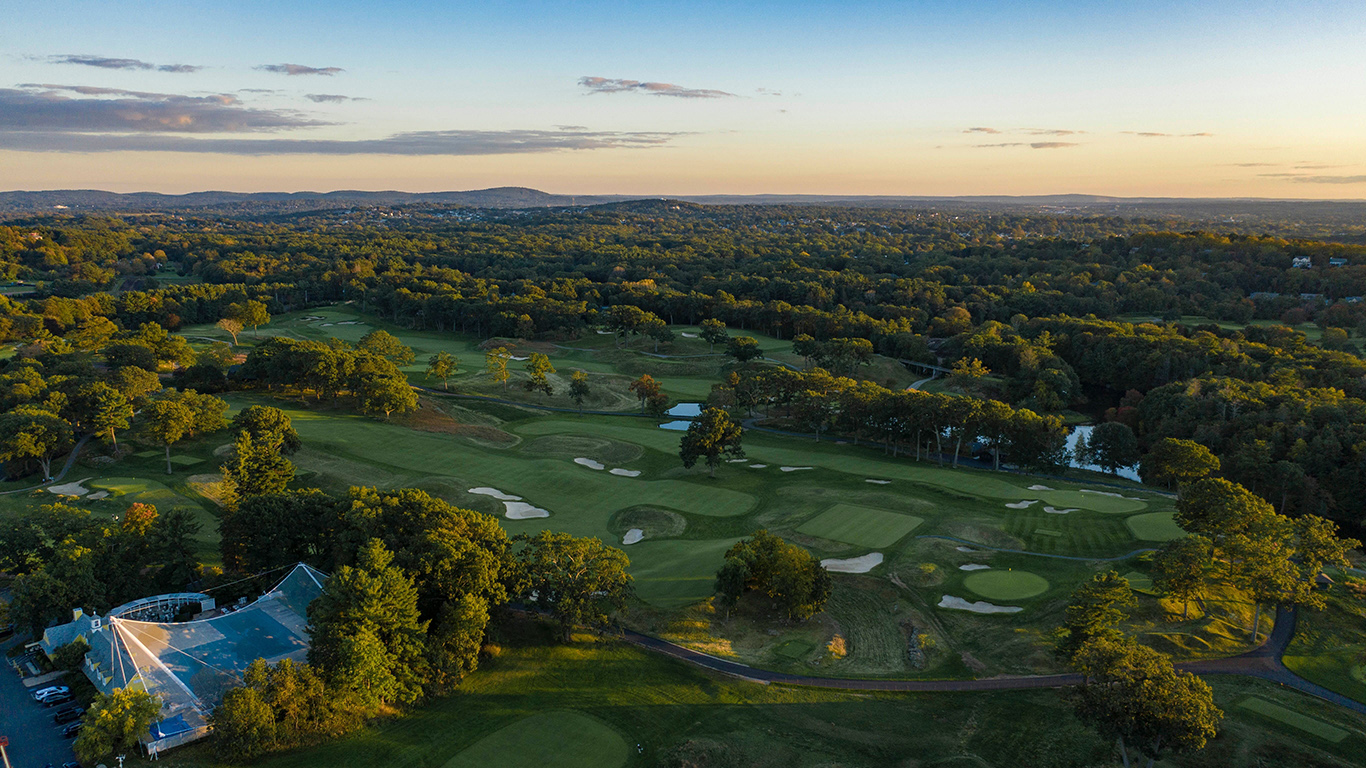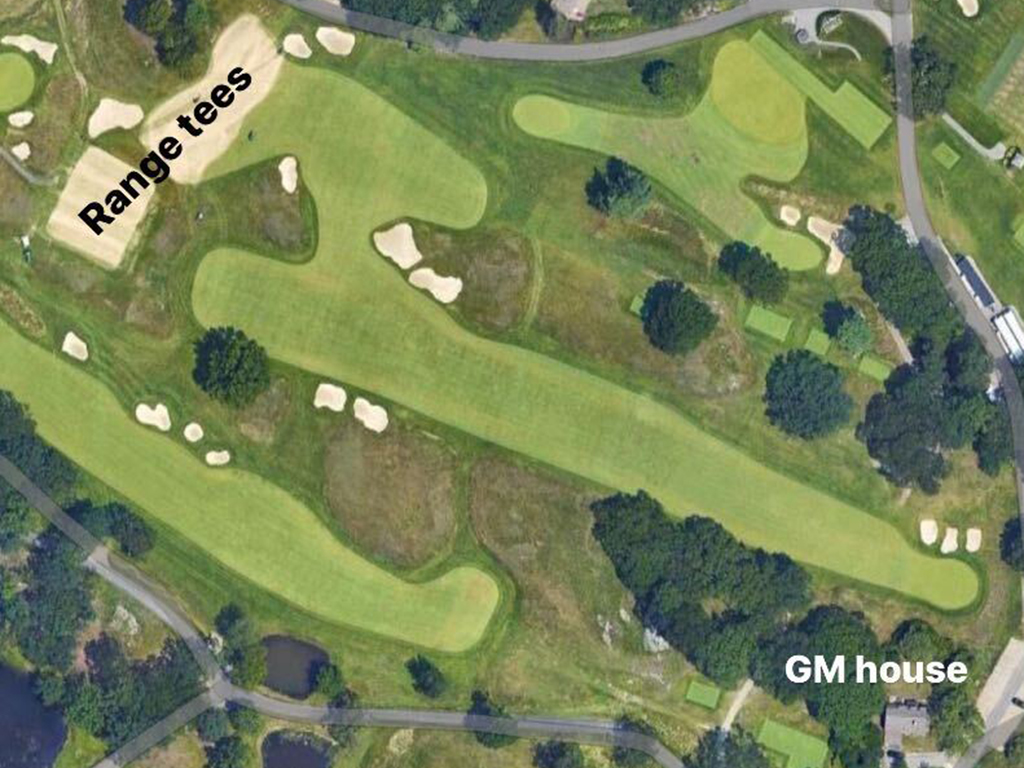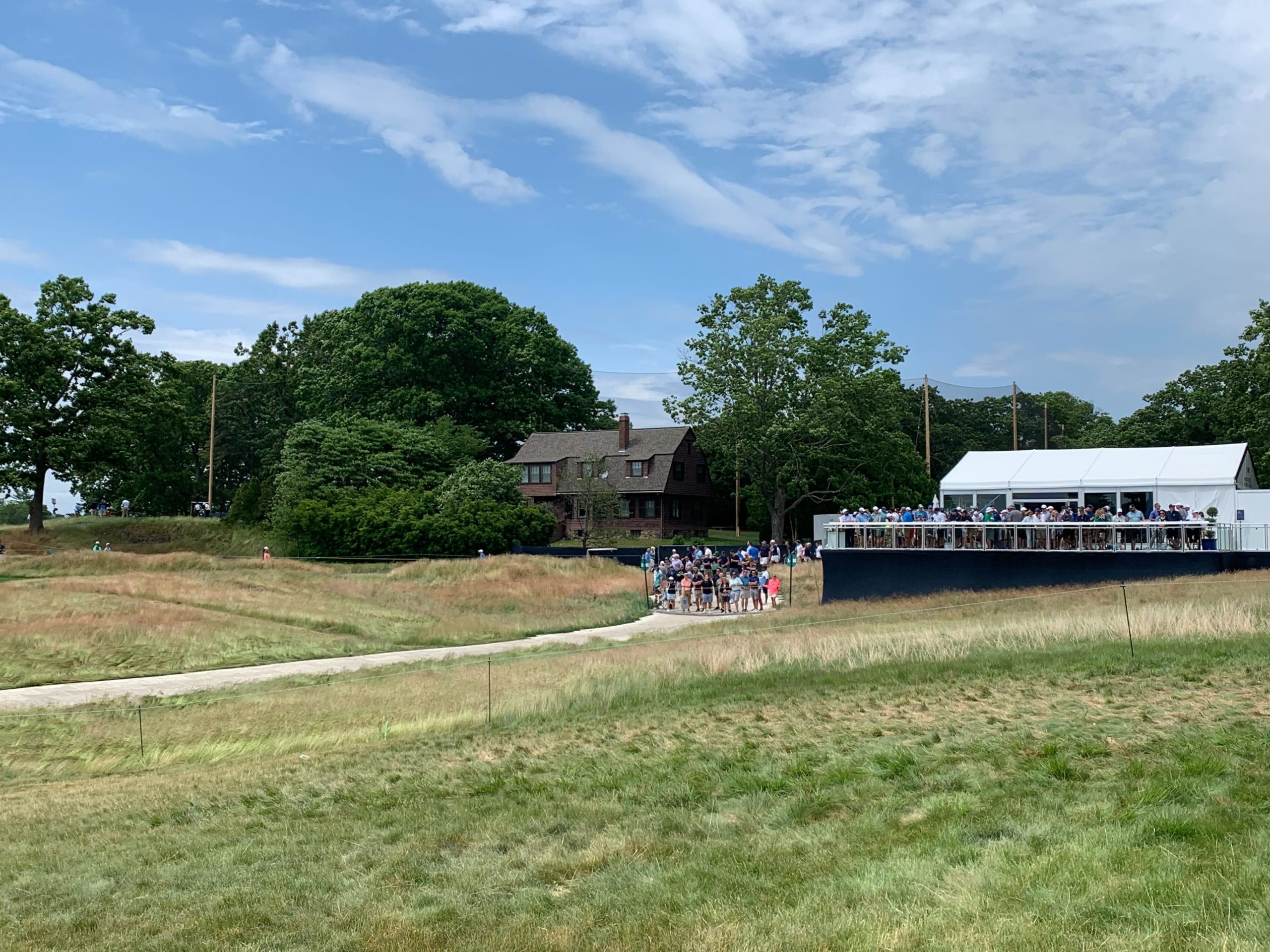Like a secret agent called away to a foreign land where the mission would not be provided until he was on the ground, Drew Cooper was asked to come to “the East Coast.” That’s still a wide swath of the United States, but eventually clarity on the destination narrowed to Boston. He would not understand why he’d come until he was in the car on his way from the airport. “I had no idea what the point was,” he said of his trip, but he did know who had summoned him.
In that car from the airport was Jason Gore, the USGA’s Senior Director of Player Relations, who delivered the mission: launch bombs to protect people in the future. Cooper, who calls himself an “amateur long driver” but has competed in a couple long drive events, was there to wail away at The Country Club in Brookline because setting up a driving range at the U.S. Open now requires foresight and prep similar to the maintenance of the actual course.
In the spring, Cooper’s coach, Dana Dahlquist, connected him with Gore, who told him to bring his clubs and come east. His initial suspicion was he’d been requested for some sort of equipment analysis, not as a ball-speed guinea pig to ensure protection for the thousands of fans, players, caddies, VIPs, and volunteers moving about the grounds in Brookline this week.
Gore outlined the impetus for Cooper’s presence on their way to The Country Club. “He told me that the goal is with guys hitting it farther and younger guys hitting it even farther, like if this [net] is going to exist and protect people who are clearly walking around the back of that range—and I think there’s a few holes that kind of end up around the back—he was like, ‘We just need to make sure no one’s gonna hit it over a net here,’” Cooper said this week. “[Gore] said ‘If we build it once, we wanna build it right. We have this area mapped out, would you mind just basically warming up and just hitting balls as hard as you can in different directions?’”
A warm-up was essential, as this was April, and Cooper described the weather as frigid, estimating the temperature was easily in the 40s. Gore and Cooper marched out to a plotted tee area for the trial while others were stationed around the back. Cooper has topped out at 217 miles per hour ball speed, and has hit it 434 yards in competition. He did not use long-drive equipment but rather a standard driver and spent about 90 minutes bashing away from every angle. On this cold day in April, he maxed out around 205 mph, with drives measured on the launch monitors registering in the vicinity of 380 yards.
The USGA earmarked the U.S. Open range to cover the ninth and 10th holes of the traditional “Clyde and Squirrel” routing the members play at The Country Club, holes that are not part of the championship routing at this 27-hole facility. This tract is in the center of the property, close enough to the clubhouse, but more consequentially, adjacent to a home that sits in the middle of the course, a quirk of the “village” planning of this historic club. The club’s general manager, the first woman to hold that position in its 140-year history, occupies the house with her family. Kids play in a yard that is surrounded by one of the most famous golf courses in the world.

The area of The Country Club occupied by this week's driving range. Photo: Andy Johnson

The proximity of The Country Club's general manager's house to the driving range (Google Earth)
“Their cars were parked out there and they had me hitting it over there and supposedly I almost hit the car. I was like inches away from hitting the car on one. And then multiple times I almost hit the house. So they beefed up the net height over there.”

The house at the back of the range, protected by a portion of the significant net build-out that's become a part of the landscape this week. Photo: Brendan Porath
It would not have been the first busted windshield around a range like this one. Such dangers have become an almost weekly predicament in high-level golf, with the ball flying farther than ever and elite players optimized to swing faster. There were broken windshields and “explosions” into sheds and other structures at Torrey Pines this year, where Farmers Insurance Open executive director Marty Gorsich told Golf Digest, “We’re not freaking out, but you’ve got this factual issue. The guys are getting longer, and unless there’s some kind of change [with limiting distance], it’s a problem that’s not going to get better and has the opportunity to get worse.” There was the comical makeshift scene of a crane at Harbour Town holding an additional net after Bryson DeChambeau launched balls into adjacent fairways and houses there a year prior. There was word of a hurried adjustment to netting at the U.S. Open two years ago, when balls started entering areas where cars were parked at Winged Foot. It’s a continual problem we’ve documented on almost a monthly basis. We’ve even suggested that golfers go cut off a piece of a cleared range net every time it happens like a basketball team does when they win a tournament.
This mix of hasty and planned measures to address this problem has not been without cost and effort, and it’s not surprising Gore took the steps he did to figure out just how far and fast things might get at The Country Club.
The proposed range was not the only place on the property where Cooper was put to work. He and Gore went out to hit tee shots on several holes. Cooper said he hammered drives at the fantastic third hole, which pinches in and forces a strategic decision; the drivable par-4 fifth hole; and the monster par-5 14th hole, where he hit it 384 yards down the center and had only 240 into the green. “They were kind of like, ‘OK, didn’t see that,’” said a chuckling Cooper of the reaction to the path he took at the uphill monster.
A peek was taken from the 17th tee box as well, the site of The Country Club’s most famous competitive moments. In our preview video, Gil Hanse expressed some concern about how the hole might play.
Cooper told the USGA when they took him around that he’d “hit driver every time,” just a “smooth” one to the front of the green.
To Gil's point, I watched Rory drive one into the greenside bunker and then hit another layup with an iron.
Another player lamented not having a 7 wood to clear the 2nd bunker and avoid going through the fairway…
Should be a fun hole to watch, especially if it's downwind. https://t.co/1fVut8TaIq
— Andy Johnson 🍳 (@AndyTFE) June 15, 2022
The long driver also went to the ninth, which forces a layup off the tee thanks to a severe mound that kicks balls into a hazard. There, he said he would hit driver because he thinks he’d fly the water, and also told the USGA he thought Bryson DeChambeau would hit driver.
DeChambeau, who has become enamored with the long-drive subculture and dabbled with actual competitions, has exchanged messages with Cooper on social media and sent him some equipment from his manufacturers. “He’s been very generous, to be honest,” Cooper said of the 2020 U.S. Open champ. “We’ve chatted very briefly in messages talking about ball-speed numbers. He asked, ‘Why does it look easy?’ when I hit the ball far.”
We approached DeChambeau this week on the subject of the range undergoing a long-drive stress test, and he was pleased to hear Cooper had been brought out for the review. “I think it’s good, but it depends on how fast I get going,” he said of the net at the end of the range this week. He also wanted to make sure the house behind it was protected, and was incredulous when we told him actual people live there.
The skillsets of professional long drive and professional tour golf are not identical but increasingly overlapping. Cooper’s tests were instructive, and he said the USGA moved the range net back some 30 yards and made plans for it to be taller after his first session in April. On Tuesday, a caddie gunned it at 343 to 350 yards away from the practice tees. Charlie Reiter, a speed demon and one of the longer hitters in the field this week, did not seem to be threatening to clear it, aside from the occasional hard hook or two.
◊
There was a second Cooper session, the first day the club closed down to members earlier this month. This visit amounted to a 30-minute session “peppering” away at the range setup in Brookline. Had they constructed a successful bomb-containment chamber? “I still flew it over the left-hand side, I want to say fairly easily, but I’m talking like far left-hand side with a hook. Then down the middle of the range, from the middle of the driving range, I was hitting about halfway up the net. So it was close, but wasn’t getting over from what I understand.”
So containment seems accomplished down the middle, where the 203 to 205 mile per hour balls from his first session had been sailing over the initially planned net. But that’s just where the USGA is hoping the players will aim. “There’s going to be a problem, I think, if guys purposely aim left on the driving range or purposely aim far right—it gets pretty short,” Cooper said. “But as long as they’re like decent humans and aim up the center of the range, it should be pretty much okay.” Granted, the human decency of pro golfers seems to be debatable these days. But unless there’s some malintented or yippy player standing on the tee, the range does seem to be safe, thanks to Cooper’s assistance.
That a long-drive hitter needs to be summoned just to set up a driving range is likely a subject of lament among those who feel distance gains are out of control, obsoleting courses and endangering their occupants. Whether Cooper might be needed again is another issue for the USGA to wrangle with in its ongoing Distance Insights Project and the potential rollbacks it may trigger. For now, the ball goes where it goes and due diligence must be taken. “I give credit to Jason [Gore],” Cooper said. “His understanding of where the game is and what guys are doing is really cool. So for them to build championship courses and be like, ‘No, no, no, we’ve gotta put thought into all of this stuff.’”


 by
by 
